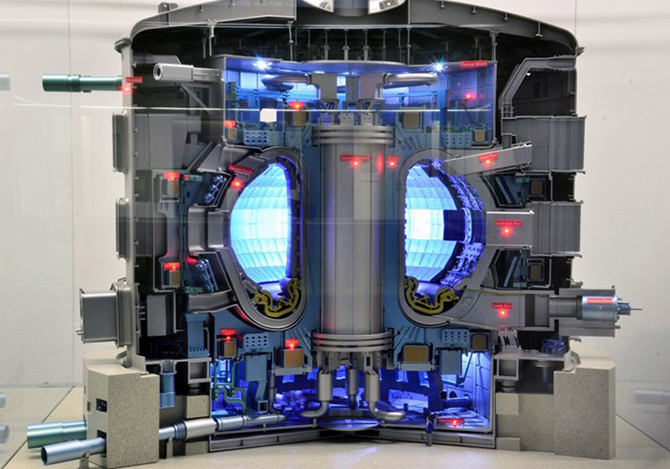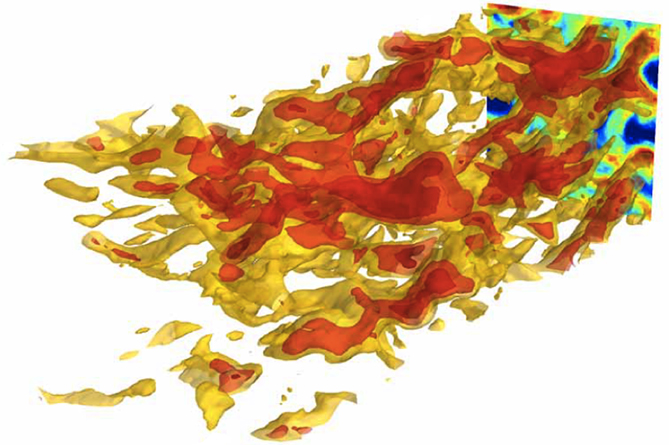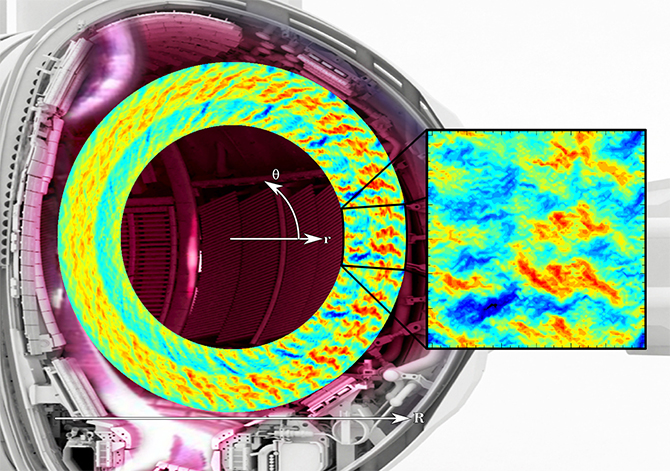Clean power through fusion
Chalmers researchers are working to improve the design of tokamaks - devices that can produce clean power through fusion.
by Hans Nordman, Pär Strand, Daniel Tegnered and Andreas Skyman, Plasma Physics and Fusion Energy Group, Department of Earth and Space Sciences, Chalmers University of Technology
Hans Nordman and Pär Strand are leading researchers at the Plasma Physics and Fusion Energy Group in the Department of Earth and Space Sciences at Chalmers University of Technology in Gothenburg where they are working on ways to provide clean energy through fusion. Their work involves modelling fusion processes in devices known as tokamaks, which are used to control the fusion reaction and to contain the plasma that provides the fuel for the reaction. Plasma is the fourth state of matter and occurs where temperatures are so high that the atoms are stripped of their electrons. The particles in a plasma are therefore charged and will gyrate around and follow magnetic field lines. This makes it possible to confine the hot plasma, and prevent it from touching the walls of the tokamak, using magnetic fields. In tokamaks, the magnetic field resembles a doughnut, often with a D-shaped cross-section as shown in the model of the ITER tokamak.

Why fusion?
Daniel Tegnered (a postgraduate student in the group) and Andreas Skyman (a recent postgraduate student in the group) explain that the advantages of fusion are that the reactions release vastly higher amounts of energy per nucleon than fission reactions, and that fuel suitable for fusion is available globally anywhere on Earth. Fusion thus has an enormous potential as a clean, safe, and environmentally friendly energy source and, due to the large amounts of energy that it is releases, fusion is one of the few energy sources that could potentially replace all the fossil-fuel-based energy sources. At present, researchers around the world are working on developing safe and effective fusion reactors, and this requires performing experiments to determine what type of reactor design and fuel are most suitable.
Having to build reactors of different shapes and using different materials, and then test them all in various scenarios would be prohibitively expensive, and hence the research group is concentrating on modelling fusion reactions mathematically. Being able to model and predict the behaviour of future fusion experiments, like the experimental reactor ITER that is currently being built in the south of France, is important both in order to understand the physics of fusion reactions and to dictate what experimental setups are actually considered. The economic and time constraints mean it is likely that all the fusion experiments that are performed physically will be preceded by extensive predictive modelling.
The simulations that the Chalmers group have performed on PDC’s supercomputer resources, amongst others, have resulted in a better understanding of the scaling of transport properties (such as the way that heat or particles flux inwards or outwards within the plasma) with reactor-relevant parameters. In particular, the shape of the impurity density profile in the fusion plasma has a strong impact on the performance of fusion reactors and these effects have been studied in detail.

How fusion works
Fusion relies fundamentally on the same physical principle as fission: transmuting elements in such a way that the reactants (that is, the elements that are the fuel) lose mass per nucleon, which yields a net excess of energy. In fusion processes, lighter and normally stable elements are fused to form heavier elements, for example, fusing hydrogen to produce helium and energy.
Fusion requires exotic conditions: intense pressure or fantastically high temperatures. In the Sun, pressures far beyond those that have been achieved on Earth facilitate the fusion of protons, but the most favourable route to fusion for power production relies on the latter alternative, namely extreme temperatures. In the largest currently operational fusion experiment, the Joint European Torus (JET), temperatures of 100,000,000 K are routinely achieved, which is what is necessary to efficiently fuse the hydrogen isotopes deuterium (D) and tritium (T). JET and ITER are both examples of tokamaks, which are the most widely researched class of device for controlling fusion-plasma using magnetic confinement.
Turbulence and designing an efficient tokamak
To design a tokamak that is suitable for producing energy via fusion, we have to consider how the fusion plasma will behave inside the tokamak. To this end, we need to look at the dynamics of fusion plasmas, that is, how the plasma will move and behave. The dynamics are generally divided into two categories: stability and transport. Here “stability” refers to global-scale dynamics, affecting the whole bulk of the fuel plasma, whereas “transport” encompasses smaller-scale phenomena occurring within the plasma. The stability of fusion plasmas can often be understood and studied using Magnetohydrodynamics (MHD), whereas studying the transport phenomena requires more advanced physical models (which are closer to the first principles of plasma dynamics as described by the kinetic Boltzmann–Vlasov equation). When it comes to determining feasible operating scenarios for future fusion power plants, both stability and transport are important, although modelling the transport phenomena is the harder problem.
To produce cheaper, optimised fusion devices with a good level of power output, we need to control the transport. This is because, to achieve a power breakeven, where we get as much (or more) energy from the fusion reactions as we put into the plasma, the so-called fusion triple product (which is the product of density, temperature and confinement time – a measure of how quickly the energy would be lost from the plasma if power was not supplied) must exceed a critical value. However, the temperature and density are constrained respectively by the need to maximise the fusion cross-section and to maintain global stability. Consequently the only way to improve the energy return from the tokamak is to increase the energy confinement time.

This image shows a contour plot of the fluctuating part of the electrostatic potential superimposed on a cross-sectional image of the JET tokamak. The electrostatic potential is related to the potential energy of the charged particles in the electric field. The fluctuations in this electrostatic potential give a measure of how strong the turbulence is.
Unfortunately turbulent transport, which leads to a shorter confinement time, is unavoidable as small-scale instabilities in the plasma are caused by the necessarily large variations in temperature and pressure across the plasma, and these small-scale perturbations turn turbulent. Being able to model the properties of these processes is crucial for improving our theoretical understanding of the way fusion plasmas behave and thus predicting suitable tokamak configurations. The mathematical computations for this kind of modelling work are extremely time consuming and complex, requiring hundreds of hours on the world’s fastest supercomputers. Researchers are seeking ways to make the computations for modelling this kind of turbulence less expensive; the gyrokinetic method is one such approach – it uses the fact that the gyrating motion of the charged particles around the magnetic field lines is small and fast compared to other phenomena to reduce the overall complexity of the problem.
Fusion plasmas contain different impurities, in addition to the isotopes of hydrogen that form the fusion fuel, and such impurities are also subject to this type of turbulent transport. These impurities can come from the wall of the tokamak reactor chamber where materials such as tungsten and beryllium are used. These additional impurities can release energy in the form of radiation and also effectively dilute the plasma, thus lowering the power output of the reactor. There are also other sources of impurities such as gases that are injected for control purposes and the helium ash that results from the fusion reaction.
To reduce the effects of these types of impurities on the final power output, it is important to determine whether the impurities and fuel ions move outwards towards the wall or inwards towards the centre of the plasma. The GENE program code (http://gene.rzg.mpg.de) has been used to investigate various experimental parameters relevant to the JET tokamak, such as how the shape of the cross-section of the plasma — the so-called magnetic geometry — affects the impurity transport. The dependence of the scaling of relevant parameters on the main ion transport (that is the transport of the most common types of ions in the plasma, which are usually deuterium in most current experiments) and how this, in turn, affects the impurity transport have also been explored. Currently the researchers are investigating the differences in the transport of heat and particles resulting from changing the materials in the reactor walls at JET from carbon-based to metal-based (beryllium and tungsten). These simulations have been run on PDC’s Lindgren supercomputer, which is currently the only Swedish HPC resource capable of meeting the computational demands of the non-linear GENE simulations required, and the group is looking forward to being able to extend their simulations with Beskow’s increased computing capacity.